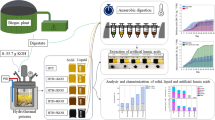Abstract
In model, pot and field trials the effect of C reduced slurries and different application techniques on N losses and N immobilization were investigated. The C reduced slurries were produced by mechanical separation. Ammonia losses from surface-applied and injected cattle slurry were measured under field conditions using a wind tunnel system. Injection of slurry was the most efficient way to reduce volatilization of ammonia. After 6 days the total loss from the injected slurry was only 9% of that from surface band application. Furthermore, additional losses of N may occur through denitrification, specially after injection of slurry which may create an anaerobic environment abundant in readily oxidizable C. Therefore denitrification measurements by the acetylene inhibition technique were conducted. Until 100 days after application the loss from the injected slurry was 7.3 kg compared to 4.5 kg N ha−1 from surface band applied slurry. After injection, denitrification was only 4.1 kg N ha−1 for C reduced compared to 6.5 kg N ha−1 for normal slurry. In pot trials the ammonium-15N of normal slurry and C-reduced slurry was utilized by oats between 52 and 60%, the ammonium sulfate by 67%. The increased biomass C confirmed a greater immobilization of the NH4-N of the normal slurry resulting in a lower initial efficiency.
Similar content being viewed by others
References
Anderson JPE and Domsch KH (1978) A physiological method for the quantitative measurement of microbial biomass in soils. Soil Biol Biochem 10:215–221
Aulakh MS, Doran JW and Mosier AR (1991) Field evaluation of four methods for measuring denitrification. Soil Sci Soc Am J 55: 1332–1338
Comfort SD, Kelling KA, Keeney DR and Converse JC (1990) Nitrous oxide production from injected liquid dairy manure. Soil Sci Soc Am J 54: 421–427
Crutzen PJ (1981) Atmospheric chemical processes of the oxides of nitrogen, including nitrous oxide. In: Delwiche C C (ed), Denitrification Nitrification and Atmospheric Nitrous Oxide Wiley, New York pp 17–44.
Dosch P and Gutser R (1993) Strategien zur Optimierung der N-Wirkung der Gülle. Landw Forsch, Kongreßband 1993, VDLUFA-Schriftenreihe 37: 121–124
Gutser R and Dosch P (1994) Cattle-slurry-15N turnover in a longterm lysimeter trial. Proceedings VIII. Int Symp CIEC on Fertilizers and Environment, Salamanca. In: Developments in Plant and Soil Sciences Series, Kluwer Acad. Publ., Dordrecht, Netherlands (in press)
Hutchinson GL and Mosier AR (1981) Improved soil cover method for field measurement of nitrous oxide fluxes. Soil Sci Soc Am J 45: 311–316
Lockyer DR (1984) A system for the measurement in the field of ammonia through volatilization. J Sci Food Agric 35: 837–848
Messner H and Amberger A (1988) Composition, nitrification and fertilizing effect of anaerobically fermented manure slurry. Proc. IV CIEC Symp. 1987, Braunschweig-Völkenrode 1: 125–130
Rank M, Huber J and Amberger A (1988) Model trials on the volatilization of ammonia following slurry application under controlled climate and field conditions. Proc. IV CIEC Symp. 1987, Braunschweig-Völkenrode 1: 315–320
Sawyer JE and Hoeft RG (1990) Effect of injected liquid beef manure on soil chemical properties and corn root distribution. J Prod Agric 3: 50–55
Schulze ED, de Vries W, Hanks M, Rosén K, Rasmussen L, Tamm SO and Nilsson J 1989 Critical loads for nitrogen deposition on forest ecosystems. Water Air Soil Pollut 48: 451–456
Sommer SG and Olesen JE (1991) Effects of dry matter content and temperature on ammonia loss from surface-applied cattle slurry. 20: 679–683
Sommer SG, Olesen JE and Christensen BT (1991) Effects of temperature, wind speed and air humidity on ammonia volatilization from surface-applied cattle slurry. J. Agric Sci 117: 91–100
Sommer SG, Jensen ES and Schørring JK (1992) Leaf absorption of gaseous ammonia after application of pig slurry on sand between rows of winter wheat. Air Pollution Research Report 39. Commission of the European Communities, Bruxelles, Belgium. pp 395–402
Thompson RB, Ryden JC and Lockyer DR (1987) Fate of nitrogen in cattle slurry following surface application or injection to grassland. J Soil Sci 38: 689–700
Van Breemen N, Mulder J and Van Grinsven JJM (1987) Impacts of acid atmospheric deposition on woodland soils in the Netherlands. II. Nitrogen transformations. Soil Sci Soc Am J 51: 1634–1640
Van der Molen J, Van Faassen HG, Leclerc MY, Vriesema R and Chardon WJ (1990) Ammonia volatilization from arable land after application of slurry. 1. Field estimates. Neth J Agric Sci 38: 145–158
Vilsmeier K (1984) Bestimmung von Dicyandiamid, Nitrat und Nitrit in Bodenextrakten mit Hochdruckflüssigkeitschromatographie. Z Pflanzenernähr Bodenkd 151: 459–473
Author information
Authors and Affiliations
Additional information
Dedicated to Prof. Dr. A. Amberger on his 75th birthday
Rights and permissions
About this article
Cite this article
Dosch, P., Gutser, R. Reducing N losses (NH3, N2o, N2) and immobilization from slurry through optimized application techniques. Fertilizer Research 43, 165–171 (1995). https://doi.org/10.1007/BF00747697
Issue Date:
DOI: https://doi.org/10.1007/BF00747697




